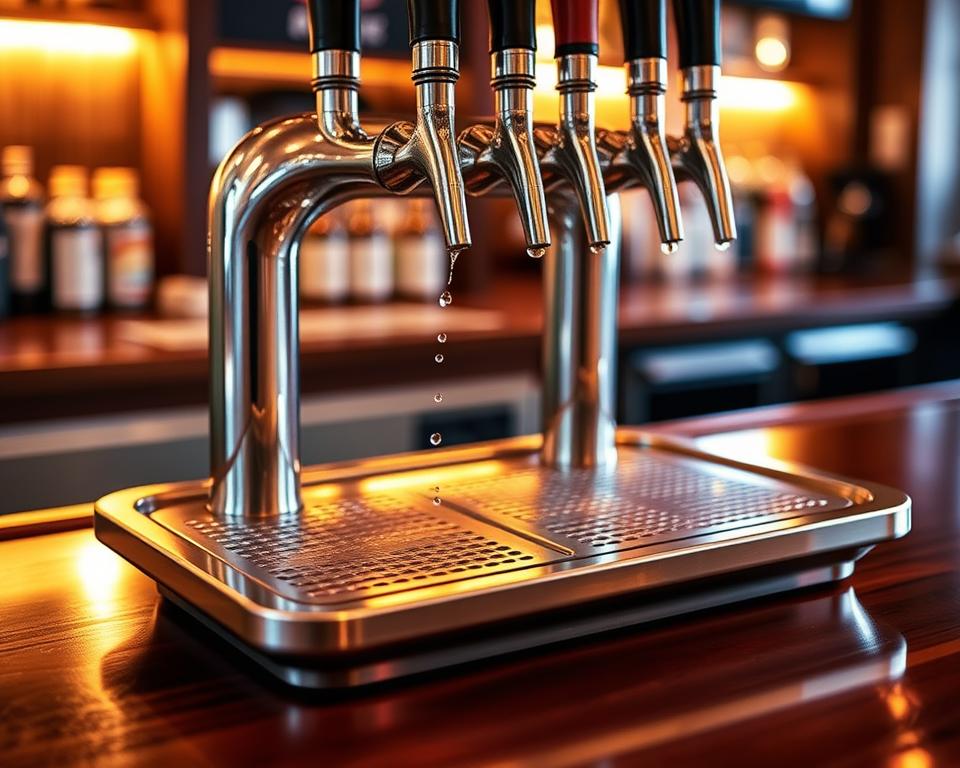Grease Trap Emptying: Keep Your Kitchen Sanitary & Secure
A single restaurant can generate up to 2,000 gallons of grease waste annually. This accumulation of fats, oils, and FOG in commercial kitchens threatens plumbing systems and the environment. Such a figure highlights the vital role of grease trap pumping in keeping a sanitary, safe kitchen environment.
Routine grease trap pumping cost is essential for both operational efficiency and environmental compliance. By working with seasoned commercial plumbing services, such as All In Sanitation Services, you can dodge significant fines and environmental harm. This guarantees your establishment stays in optimal condition.
Understanding Grease Traps and Their Significance
Grease traps are essential in commercial kitchens, handling the significant amounts of fats, oils, and FOG produced during food preparation. These units stop damaging substances from entering public sewer systems, protecting wastewater treatment processes.
What are Grease Traps?
Engineered to capture and isolate fats, oils, and grease from wastewater, grease traps are essential in restaurants and food establishments. They guarantee that unwanted materials do not clog drains or contaminate public sewage systems. The setup usually includes a tank that temporarily stores wastewater, allowing grease to rise and accumulate while heavier solids sink to the bottom.
How Grease Traps Work
The functioning of grease traps relies on gravity separation. When wastewater enters the trap, grease floats to the top due to its lower density, while denser particles settle at the bottom. This process minimizes the amount of grease entering drainage systems, facilitating effective fats oils and grease disposal.
Key Role in Kitchen Hygiene
Regular cleansing of grease interceptors is vital for kitchen hygiene. An overflowing or blocked grease trap can lead to unpleasant odors and draw pests. Effective grease trap pumping and maintenance guarantee a sanitary environment, avoiding sanitation problems that could endanger food safety.
Why Routine Grease Trap Emptying is Essential
Regular grease trap emptying is crucial for a secure and effective kitchen environment. It plays a key role in preventing drain clogs, ensuring environmental compliance, and lowering odors and pest infestations.
Avoidance of Drain Clogs
Routine emptying of grease traps avoids drain clogs. Fats, oils, and FOG can accumulate and clog the drains, interrupting kitchen operations. By maintaining grease traps, businesses can prevent costly repairs and guarantee uninterrupted operations.
Compliance with Environmental Regulations
Many cities have strict rules about how to dispose of grease. Businesses must follow these regulations to safeguard the municipal wastewater system. Routine pumping of grease traps helps businesses stay compliant, preventing fines and legal issues. It shows a dedication to responsible business methods.
Minimization of Odors and Pest Infestations
A clean grease trap reduces bad odors from decaying organic matter, creating the kitchen more pleasant. It also reduces the risk of pests like rodents and insects. Routine pumping of grease traps enhances food service sanitation and hygiene.
Grease Trap Pumping: The Process Detailed
The grease trap emptying process is essential for a sanitary kitchen environment. It ensures waste, especially fats, oils, and FOG, is handled efficiently. This minimizes harm to plumbing systems.
The Significance of Correct Cleansing Procedures
Following proper cleaning procedures is vital for grease trap effectiveness. These methods ensure complete cleaning, avoiding future clogs and odors. All In Sanitation Services emphasizes the significance of systematic cleansing, concentrating on grease and debris elimination. This ensures the grease trap working well and complies with local laws on fats oils and FOG disposal.
Steps Involved in Grease Trap Emptying
The grease trap pumping process involves several essential steps:
- Initial Evaluation: Evaluate the size and condition of the grease trap.
- Evacuation: Thoroughly remove the contents, including liquid and solid waste, to ensure a clean start.
- Cleansing: Use specific equipment to clean the trap, breaking down any hardened grease buildup.
- Residual Waste Removal: Use a shop vacuum to remove any remaining waste.
- Inspection: After emptying, conduct a complete check to guarantee the trap’s components are undamaged.
By following these steps, the risk of overflow is reduced. It also prolongs the life of the grease trap and septic tanks, improving kitchen effectiveness.
Wrapping It Up
Grease trap maintenance and regular emptying are essential for commercial kitchens to function well. Ignoring these steps can cause major problems, including non-compliance with regulations, health risks, and unexpected interruptions. Taking care of grease traps is essential for kitchen safety and the success of diners.
Working with professionals like All In Sanitation Services can enhance grease trap maintenance. This collaboration assists businesses meet environmental standards and creates a safe kitchen environment for employees. Such actions prolong the life of kitchen equipment and improve food hygiene.
Regular grease trap pumping ensures a efficient kitchen operation and avoids fines. Implementing these methods leads to a more sanitary, healthier, and more efficient kitchen environment for all involved in food cooking.



